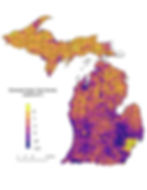Protecting Homeowners and Our Waters: Septic Systems of Mid-Michigan
- NEWS
- Sep 18, 2023
- 8 min read
Updated: Nov 20, 2023
Life for rural residents often includes open spaces, pastoral views, an unpolluted night sky, and most likely their own private drinking well and septic system. Across the tri-county region alone, Clinton, Eaton, and Ingham counties are estimated to have over 41,000 septic tanks.
Looking at the state of Michigan as a whole with 1.3 million septic systems and counting, it’s understandable that the responsibility of knowing how a septic system works and what to do to properly maintain it falls on the homeowner.
The water used to cook food, clean the dishes, do the laundry, and keep a family running day-to-day must leave the house as wastewater to be treated and returned to our natural environment. One of the most common systems for septic management of wastewater on a private property is referred to as a conventional system. This is made up of a two-part system which includes a septic tank and a drainfield.
The wastewater leaves the house through one main pipe, which enters a septic tank. This is usually a large tank made of concrete, fiberglass, or polyethylene and buried 10 feet or more from where the main pipe leaves the house. The tank will either have one or two compartments to start the treatment process. Your property size will play a large role in whether you have one or two tanks. Usually, households or businesses with higher water usage and larger available space on a property will be more likely to have a two compartment tank rather than a single compartment.
Though a lot happens underground, septic tanks aren’t something you can see outside your window. They may be a mound of earth or a hill in your yard while others have easily visible access panels for pumping. Either way, they don’t impact the view of your property!
Once the semi-treated wastewater leaves the septic tank, it will use an outlet tube to enter the drainfield. Often viewed as a wide grassy space in your yard, a drainfield is the last stop before wastewater is dispersed into the soil. To access this infrastructure, the amount of wastewater you send down your main pipe is the amount naturally pushed into the drainfield from your septic tank. This helps to prevent the sludge and scum from entering this phase of the treatment process. Made up of a series of underground perforated plastic pipes that are laid on a bed of gravel, drainfields slowly release semi-treated wastewater over soil to finish treatment.
The size of the drainfield is determined based on the estimated amount of wastewater produced by the home and the type of soil found in the desired location. These natural purification processes work best in soils that are somewhat dry, highly permeable, and contain lots of oxygen to promote the breakdown of the remaining pollutants in the wastewater.
Both drainfields and septic fields are critical pieces of infrastructure for homes without connections to a public sanitary sewer system. The homeowner is solely responsible for inspecting, maintaining, and repairing their septic infrastructure. An inspection of the system should usually occur during the inspection period when properties are sold.
When your home is not on the market, your septic system should be inspected at least every three years and pumped every three to five years. A hired septic service provider will inspect for leaks and examine the scum and sludge layers in your septic tank. Keep track of their findings to help you determine when your next pumping is needed.
How Do Septic System Impact Our Waters?
Proper septic maintenance helps protect your property value. More importantly, maintaining your septic system protects public health. Unfortunately, septic systems are a significant source of groundwater contamination. If left untreated, the bacteria, protozoa, and viruses found in wastewater can cause numerous diseases such as cholera, hepatitis A, typhoid, and gastrointestinal illnesses.
In fact, the U.S. EPA reports septic systems are one of the top 5 sources of pollutants in surface water bodies; which include E. coli and nutrients like nitrogen and phosphorus. These pollutants can have a big impact on recreation. When high levels of E. coli bacteria are found in surface waters, health officials will close beaches, lakes, and fishing areas for our safety. Exposure to the bacteria can cause severe stomach cramps, bloody diarrhea, and vomiting in people and pets.
Excess nitrogen and/or phosphorus can cause harmful algal blooms from an overgrowth of blue-green algae or cyanobacteria. These bacteria produce a toxin that causes dead zones to form in the water. Humans and pets can also suffer gastrointestinal and respiratory distress from exposure to cyanobacteria.
“Failing and aging onsite septic systems are a major source of surface and groundwater pollution,” explained Patrick Klein, Environmental Quality Analyst with Michigan’s Department of Environment, Great Lakes, and Energy. “If not maintained, septic systems can contaminate groundwater and harm the environment by releasing bacteria, viruses, and household toxins to local waterways. Scheduling regular septic system inspections and small changes in habits will prevent contamination in our waters, improve public health, and increase the lifespan of your septic system.”
Preventative Tips for Homeowners
Potential contamination of ground and surface waters from a septic system is one of many reasons you should never dump household hazardous wastes down the drain. Words like ‘warning’, ‘caution’, ‘flammable’, ‘toxic’, ‘poison’, ‘corrosive’, and ‘oxidizer’ on the label indicate the product is hazardous. Visit MyWatersheds.org for a list of household hazardous waste collections and information on properly disposing of waste in the tri-county region.
Homeowners should also think at the sink. Using caution in what you send down the drain can improve the life of your septic field. Avoid grease, fats, oils, and coffee grounds that clog your septic system. Ditto for your toilet; diapers, flushable wipes (even when they say “septic safe”), cat litter, cigarette butts, and feminine hygiene products routinely clog septic systems.
With a little effort, there are many ways in which homeowners can extend the life of their septic system. Here’s some easy tips:
Mark your calendar to inspect every 3 years and pump every 3-5 years.
Avoid garbage disposals to further reduce clogs from fats and solids in your drainfield.
Use water efficiently to improve the lifespan of your septic system. Faucet aerators and high-efficiency toilets and showerheads reduce water flow and the volume of water entering your septic system.
Repair leaking faucets and toilets
Wash only full loads in the dishwasher or washing machine and spread out loads of laundry throughout the week.
Do not park or drive on your drainfiled, and plant trees from a distance. Tree roots can interfere with the wastewater treatment process.
Avoid draining sump pumps, water softeners, or rainwater drainage systems onto your drainfield, it can overload your septic system.
Never drain your pool or hot tub directly onto your septic field or down a storm drain. Drain into the sanitary sewer or a location on your property far from the septic field and bodies of water.
The location of your septic field in relation to your private well is also a concern. Failure in a septic system can allow untreated wastewater to access local groundwater sources, which supplies our tri-county region with drinking water. This then leads to the well bringing the contaminated well water into the home where it is used for consumption and cleaning.
It is recommended to test your well water annually for at least bacteria and nitrates/nitrites, which are a good indicator of whether potential untreated wastewater could be entering your drinking water system from your drainfield. If a new well is being installed, make sure to check with your local health department about guidelines for how far away to site your well from a septic system. A minimum of 50 feet is recommended by the Center for Disease Control, but your local regulations could specify a further distance.
“In the tri-county area, our communities and homeowners rely exclusively on groundwater for their drinking water needs,” said Andrea Polverento, Chairperson of the Groundwater Management Board. “Poorly maintained septic systems can cause increased contamination of nitrates and nitrites in groundwater, along with coliform bacteria. Regular inspections and taking advantage of programs like Michigan's free private well testing can inform on any issues with well and septic system.”
What To Do If Your Septic System Fails
Even with good maintenance that can help your system last 20-30 years, unpreventable failure can still happen. This includes the seal on the septic tank leaking water in or wastewater out, the system reaching the end of its life, or a natural disaster causing damage.
There are a few easy signs to look out for if failure has occurred. First, make sure to keep an eye out for any puddles or saturation around the septic tank and drainfield, which can indicate wastewater not properly draining. Backing up of wastewater in the house can occur from too much scum and sludge in the septic tank. Additionally, seeing dead spots or bright green grass different from the rest of your yard can show excess nutrients from a leak in wastewater. Lastly, even noticing a putrid smell in your yard may inform you of a potential failure.
It’s been estimated that over 10% of all septic systems nationally are in failure, with a new system costing $6,300 and upwards of $10,000. Replacing a degraded drainfield costs even more, averaging $6,000 up to $20,000. If your system fails, the first thing you should do is contact your local health department.
They can connect you with one of their staff to walk you through your options, provide contacts for certified septic system repair companies, and even help you identify potential local resources, including programs and financial aid. For more information on assistance options in Michigan, check out the Michigan Homeowner Repair and Rehabilitation Assistance program.
How Do Michigan Septic Policies Compare to Other States?
Michigan is the only state in the United States which does not have a statewide septic code. This means that regulations and permitting requirements are determined at the county level with some communities requiring stricter regulations than what is required of their neighbors. Find out what your community requires by contacting your local health department.
Certain areas in our region like Ingham County require a point of sale when selling a home or transferring property. This means that both the entire drinking well and septic system must be inspected prior to the closure and actions must be taken to bring the systems up to code if necessary.
Currently, a series of bills has been introduced in both the State Senate and House of Representatives to establish a statewide septic code. This would implement the same standards of design, construction, installation, and maintenance requirements for all private septic systems. For an update on the status of these bills, check the State of Michigan’s website: House Bill 4479 and 4480, and Senate Bills 299 and 300.
“It is abundantly clear that a unified and standardized regulatory framework for onsite wastewater treatment systems is needed across Michigan,” said Ruth Kline-Robach of MSU’s Institute for Water Research and member of the Greater Lansing Regional Committee for Stormwater Management. “Uniform regulations will ensure proper installation and maintenance of these systems, which will help to safeguard both groundwater and surface water and the overall environmental health of our state.”
Even if a new framework is not developed, septic systems are a part of life in Michigan and impact our health and environment. These systems can be an effective, nature-based tool for wastewater treatment. If builders plan appropriately and homeowners take simple preventive steps to maintain their septic systems, we can prevent groundwater and surface water pollution.
For more information on septic systems and their impacts on our waters, please contact Lauren Schnoebelen regarding drinking water questions and Amanda Hathaway Frattarelli regarding surface water and stormwater questions.
Local Health Departments Websites

To help protect local communities, the Tri-County Regional Planning Commission plans for sustainable natural resources by facilitating the Groundwater Management Board and the Greater Lansing Regional Committee for Stormwater Management.





















